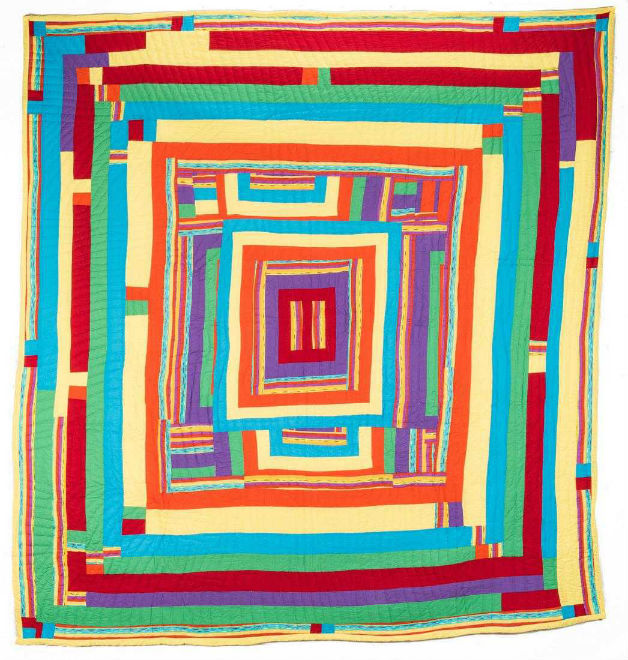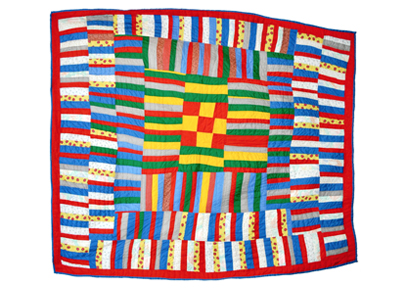
NEW YORK – The small, close-knit and rural African-American community of Gee’s Bend, Alabama, took the art world by storm in 2002 with the groundbreaking exhibition, “The Quilts of Gee’s Bend,” which showcased the homespun quilts that were dazzling in their abstract and geometric simplicity. Further scholarship and the many exhibitions that followed have given these quilts their due at last, sealing their legacy in the field of vernacular art and establishing their place as an art form.
The women of Gee’s Bend made quilts to keep warm back when their homes were unheated and lacked electricity. Mothers passed down this skill to their daughters and so on. In the late 1990s, Georgia native William Arnett, who had a growing collection of African art and folk art of the deep South, began buying hundreds of quilts from the quiltmakers directly and became their biggest champion, introducing their quilts to larger audiences. He founded the Souls Grown Deep Foundation, which works to catalog and preserve the tradition of African-American art from the Deep South.

While they pay homage to the African-American quilting tradition, the Gee’s Bend quilts have a look all their own. Many can be referred to as improvisational quilts, often taking a tried-and-true quilting pattern style like the Housetop or Log Cabin, but then the quilter puts her own artistic twist on the finished quilt, creating a highly personal and distinctive work of art.
“Quiltmakers there have produced countless patchwork masterpieces beginning as far back as the mid-19th century, with the oldest existing examples dating from the 1920s,” according to commentary on the foundation’s website. “Enlivened by a visual imagination that extends the expressive boundaries of the quilt genre, these astounding creations constitute a crucial chapter in the history of African American art.”

These quilts today are in the collections of major museums, such as the Museum of Fine Arts, Houston, which organized the historic “Quilts of Gee’s Bend” exhibition. “While many of the quilts are based on historic patterns like Housetop or Log Cabin, the quilters of Gee’s Bend take more liberties with improvisation and graphic geometric color blocking that set them apart from the expectations of a traditional quilt,” says Anna Walker, the museum’s Windgate Foundation Curatorial Fellow for Contemporary Craft.
Many of the most powerful examples show ingenuity and creativity in their constructions and composition, Walker said. “Rather than executing an expected pattern, the quilters innovate and create new designs in bold patterns.”

New York City’s Metropolitan Museum of Art has about 20 Gee’s Bend quilts in its collection, including the one that is said to have kicked off Arnett’s quest to collect these quilts. Reportedly, Arnett saw a photograph showing a particular Strip Medallion quilt by Annie Mae Young made in 1976, and was amazed by its colorful brilliance and execution, driving him to buy quilts. Other Gee’s Bend quilts in the museum’s collection embody a variety of styles from a Blocks-and-Strips work clothes quilt, circa 1950, by Emma Lee Pettway Campbell to a Bricklayer quilt by Linda Diane Bennett, circa 1970.

Perhaps given to the community’s isolated location and economic status, locked in by the Alabama River on three sides, the women here have “made do” for many years with whatever materials they had on hand, including recycled cotton work shirts, denim jeans, corduroy trousers, handkerchiefs, etc. An interesting side note is that many of the quilters got their last name, Pettway, from Mark H. Pettway, who purchased the plantation in the 1800s.

Many of the quilts from Gee’s Bend, such as Lutisha Pettway’s Bars quilt, which is in the collection of the MFAH, are known as work-clothes quilts and would have been made using salvaged cloth and used clothing worn by individuals likely known to the quilters. “These textiles foreground the history of African slavery—all of the quilters of Gee’s Bend are descendants of slaves and these works are emblems of exploited African-American labor,” Walker said. “Curator and scholar on Gee’s Bend Joanne Cubbs wrote about this best in Gee’s Bend: The Architecture of the Quilt, ‘Throughout the lexicon of African American vernacular culture, castaway objects are often used to reaffirm life, as the reinvestment of creative energy in old and worn-out things becomes a metaphor for turning adversity into spiritual triumph and for redeeming the socially dispossessed or human castaways of the world. The tradition of the work-clothes quilt is part of that practice, a potent symbol for the promise of spiritual regeneration in the face of overwhelming injustices and inhumanities.’”


